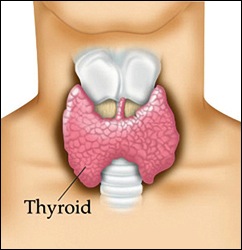Fluoride Ingestion Linked to Hypothyroidism
 Currently, there are more than 27 million Americans who have thyroid dysfunction, over half of which are never diagnosed. About 10 million women with hypothyroidism go undiagnosed and untreated. Furthermore, about 70% of my fibromyalgia and chronic fatigue patients suffer from low thyroid function. They go undiagnosed for so long because traditional blood work generally comes back normal, but the blood work is suboptimal and does not look at all factors that show hypothyroidism.
Currently, there are more than 27 million Americans who have thyroid dysfunction, over half of which are never diagnosed. About 10 million women with hypothyroidism go undiagnosed and untreated. Furthermore, about 70% of my fibromyalgia and chronic fatigue patients suffer from low thyroid function. They go undiagnosed for so long because traditional blood work generally comes back normal, but the blood work is suboptimal and does not look at all factors that show hypothyroidism.
There are millions of Americans walking around with symptoms suggestive of low thyroid function, but because one blood test did not show any abnormalities, they are told it is all in their head. Symptoms include, but are not limited to:
- Excess fatigue
- Headache
- Increased temperature sensitivity, especially cold
- Dry skin
- Constipation
- Puffiness in the face
- Weight gain
- Hoarseness
- Muscle weakness, stiffness, and pain
- Joint pain and swelling
- Hair thinning
- Depression and impaired memory
It is no surprise that many of these symptoms are associated with fibromyalgia and chronic fatigue syndrome. Normal TSH blood testing to look at the thyroid-stimulating hormone, is just the start of the investigation; however, many doctors look at it as the “be-all and end-all” of thyroid functioning. This has lead to a greater number of people suffering for longer and exacerbating their symptoms.
 Low thyroid is a reduction in all the hormones that are released from the thyroid gland located at the base of the neck. This gland is associated with metabolism and growth of the body. Additionally, it regulates several bodily functions by releasing hormones at a consistent rate. There are several known causes for low thyroid functioning including autoimmune diseases, treatment for overactive thyroid disorder, thyroid surgery, radiation therapy, certain medications, pregnancy, congenital diseases, and iodine deficiency.
Low thyroid is a reduction in all the hormones that are released from the thyroid gland located at the base of the neck. This gland is associated with metabolism and growth of the body. Additionally, it regulates several bodily functions by releasing hormones at a consistent rate. There are several known causes for low thyroid functioning including autoimmune diseases, treatment for overactive thyroid disorder, thyroid surgery, radiation therapy, certain medications, pregnancy, congenital diseases, and iodine deficiency.
There is a recent study out of England that shows high fluoridation may also be a primary cause of hypothyroidism.
The study was published online in February 2015 in the Journal of Epidemiology and Community Health. This is the first population-level study that investigated the link between hypothyroidism and fluoride levels in drinking water. In this study, a comparison was done between the West Midlands, which is a fluoridated area with 0.7 mg/L or more in the water, and Greater Manchester, which is a non-fluoridated area with 0.3 mg/L or less in the water. It was found that there was nearly twice the risk for hypothyroidism in West Midlands.
Hypothyroidism was 3.18% prevalent in England, and the UK is not so different from the United States.
This study showed that the odds of a specific practice having more patients with hypothyroidism was 1.4 times higher in areas where fluoride levels were greater than 0.3 mg/L but 0.7 mg/L or less. A hypothyroidism diagnosis was 1.6 times higher in areas where fluoride was in excess of 0.7 mg/L than in doctors’ offices and clinics that had lower or no fluoridation in their water.
Researchers believe there is a 9% elevated hypothyroidism prevalence in England because of the fluoridation. Not surprisingly, there are similar levels of fluoride in drinking water in the United States as in England.
The majority of US states aim for a fluoride level of about 1 mg/L, which is the same level as in the UK. Based on the data found in this study, however, this is far too high, even though there are federally run organizations such as WHO and the UK Medical Research Council that deep this level safe. Clearly, there is a discrepancy.
 A professor involved in the study stated, “This report, as well as other reports on the adverse effects of fluoride exposures and the lack of significant dental benefit from ingested fluoride should prompt a rethink of the whole practice of adding fluoride to drinking water.” There is a proposal in the United States that suggests fluoridation should be no more than 0.7 mg/L because the benefits for preventing dental decay are no better at levels above 0.7 mg/L.
A professor involved in the study stated, “This report, as well as other reports on the adverse effects of fluoride exposures and the lack of significant dental benefit from ingested fluoride should prompt a rethink of the whole practice of adding fluoride to drinking water.” There is a proposal in the United States that suggests fluoridation should be no more than 0.7 mg/L because the benefits for preventing dental decay are no better at levels above 0.7 mg/L.
It is noted here, too, that this study was performed on people with a confirmed diagnosis of hypothyroidism. There is still the potential for this study showing even more prevalence if we can get more confirmatory diagnoses procedures in place for people experiencing hypothyroidism symptoms.
There are plenty of debates on the effects of fluoride and what is deemed a safe level in community drinking water. There is evidence that shows high levels of fluoride is exceedingly dangerous and can cause neurological and cognitive deficits, especially in children. While it is helpful in low levels to prevent tooth decay, there is absolutely no evidence to suggest higher levels promote greater benefits.
If you have any questions regarding this post, or any others on my site, I host a FREE call-in conference each week, where I will answer one-on-one questions for people who are looking for alternative treatment methods or have any questions about my posts and recommendations. Join me this Tuesday at 8 p.m. EST, 7 p.m. CST, 6 p.m., and 5 p.m. PST.
I look forward to answering any questions you may have.












Leave a Reply
Want to join the discussion?Feel free to contribute!